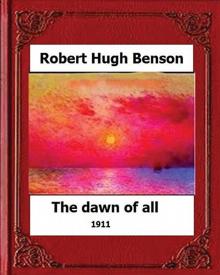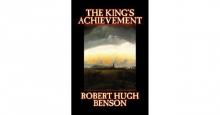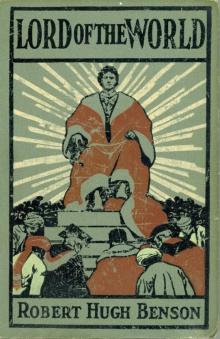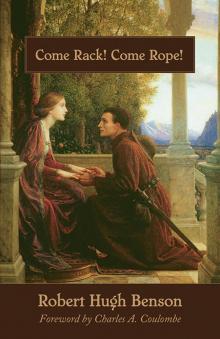- Home
- Robert Hugh Benson
Come Rack, Come Rope
Come Rack, Come Rope Read online
Come Rack!
Come Rope!
Martyrs of the sixteenth century
Come Rack!
Come Rope!
By
ROBERT HUGH BENSON
TAN Books
Charlotte, North Carolina
TAN edition copyright © 2016 TAN Books
Retypset by TAN Books in 2016. The type in this book is the property of TAN Books and may not reproduced, in whole or in part, without written permission from the publisher.
Foreword by Charles A. Coulombe copyright © 2016 TAN Books.
Cover design by David Ferris
www.davidferrisdesign.com
Cover image: The End of the Quest, 1921 (oil on canvas), Dicksee, Frank (1853-1928) / Leighton House Museum, Kensington & Chelsea, London, UK / Bridgeman Images
ISBN: 978-1-5051-0919-1
Published in the United States by
TAN Books
P. O. Box 410487
Charlotte, NC 28241
www.TANBooks.com
Printed and Published in the United States of America
Contents
Foreword
Foreword to the 1956 Edition
Part I
Chapter I
Chapter II
Chapter III
Chapter IV
Chapter V
Chapter VI
Chapter VII
Chapter VIII
Chapter IX
Part II
Chapter I
Chapter II
Chapter III
Chapter IV
Chapter V
Chapter VI
Chapter VII
Chapter VIII
Chapter IX
Chapter X
Part III
Chapter I
Chapter II
Chapter III
Chapter IV
Chapter V
Chapter VI
Chapter VII
Part IV
Chapter I
Chapter II
Chapter III
Chapter IV
Chapter V
Chapter VI
Chapter VII
Chapter VIII
Chapter IX
FOREWORD
Msgr. Robert Hugh Benson (1871–1914) is probably best known today for his chilling 1907 dystopia, Lord of the World, and, to a much lesser degree, for his equally chilling (at least to what passes for the “Modern Mind”) utopia, The End of All. But Benson’s historical novels are well worth reading; of these, Come Rack! Come Rope! is certainly the jewel in the crown. Benson himself is as fascinating as any character in his novels. In this day of the newly founded Anglican Ordinariates within the Catholic Church, and the writings of such as Fr. Aidan Nichols, O.P. about the particular need to convert England, both Benson’s writings and his own story have never been more relevant.
He came from an extremely remarkable family. His father, Edward White Benson, was a prominent Church of England cleric, whose career culminated in his appointment as Archbishop of Canterbury. His mother, Mary Sidgwick Benson, was the sister of a noted philosopher, renowned as a hostess, and acclaimed by Gladstone as “the cleverest woman in Europe.” The future Monsignor was the youngest of six remarkable children, including Egyptologist Mary Benson, author and Master of Magadalene College, Cambridge, A.C. Benson, and novelist E.F. Benson (creator of the Mapp and Lucia series and many ghost stories). Growing up in such a clan was challenging, but it produced both keen intellect and acute knowledge of people. These were the tools Robert Hugh brought with him into the Anglican ministry.
A year after his ordination in 1895, Benson’s father died. As the years went by, his piety became ever more Anglo-Catholic; after exploring several Anglican religious orders, he joined the Mirfield Fathers (the Community of the Resurrection) in 1901, and began his literary career. But prayer and research led him inescapably to the conclusion that the Papal claims were correct, and he converted in 1903. Thanks to his brilliant academic background, he was ordained the following year and sent to Cambridge where he both performed his clerical duties and wrote a stream of novels and other works. He was made a Monsignor in 1911 and died three years later.
Although noted in his day for ghost stories, and in ours for his novels of the future, it was his historical fiction that brought him the most acclaim in his own time—and they stand up well in comparison to those of, say, the great Jane Lane. For English Catholics then—and even now, to a great degree—the sufferings of their forbears under Henry VIII, Elizabeth I, Cromwell, and William of Orange were a great part of their identity. Relics of the martyrs of that period in such places as Tyburn Convent, London and Ladyewell in Lancashire remain the focus of pilgrimages. One of the most touching of these sites is Padley Martyrs Chapel in Derbyshire. The former chapel of Padley Manor, it was in the sixteenth century home of the Fitzherbert family, who have remained loyal to the Faith since the Reformation. There, in 1588, two priests—Bl. Nicholas Garlick and Bl. Richard Ludlam—were staying at the manor saying Mass for the Fitzherberts when the house was raided by Elizabeth’s “priest-catchers.” Everyone in the house was arrested, and the two priests hung under a bridge later that year. Since 1891 Catholics have made an annual pilgrimage to the site, generally with a sermon given by a prominent priest. In 1911, the honor fell to Msgr. Benson, and the place’s history became a partial inspiration for the present volume—a portion of which is set at Padley. He had first read of the Fitzherberts’ adventures the year before in Dom Bede Camm’s groundbreaking work, Forgotten Shrines, which surveyed Recusant shines and homes throughout England. The title Msgr. Benson borrowed from a letter of St. Edmund Campion, in which, after being tortured he assured his correspondents that he had disclosed “no things of secret, nor would he, come rack, come rope.” The book came out in 1912.
The action of Come Rack! Come Rope! occurs from 1577 to 1588, when both the Elizabethan persecution and Recusant counter-action were at their height. From Mary Queen of Scots to the two Blesseds captured at Padley, quite a number of real life figures are characters, alongside the fictional main protagonists. In Benson’s deft hands, the atmosphere of that time, filled alike with holiness and horror, comes alive. The real life dilemmas that afflicted those who tried to be faithful to their God are uncovered, and made as living as today’s internet news.
But there is far more to this book than its bringing of the past back to life. Some of the conflicts the characters face are endemic to the human condition—the demand of a religious vocation versus both familial and romantic love, for example, or the actual purity of one’s own motives in any endeavour. But other are specific to times when holding the Faith is an act of defiance against the established order, as it was in Elizabethan England, and as it seems increasingly in the West in our own day. How far may one compromise his principles with the state or society without becoming an apostate? If the regime under which one lives is opposed to the Faith, when, if ever, does it become legitimate to take up arms against it? When such periods arise in the life of the Church, there are seldom any easy answers to these conundra; Monsignor Benson does all of us a great favor by taking them out of the pages of history and facing us squarely with them. He does, moreover, give us an ultimate answer. Whatever prudential judgements in these areas we feel called upon to make, ultimately we must follow Our Lord, and forgive those who do us the greatest wrongs—even if those wrongs end with our being put to death. It is a hard lesson to accept, and a harder one to put into practice. But is essential if we are to save our souls, and Msgr. Benson deserves our gratitude for reminding us of it so very poignantly.
Charles A. Coulombe
September 20, 2016
Feast of St. Eustace
FOREWORD TO THE 1956 EDITION
COME RACK, Come Rope was first published in 1912. It quickly became established as a Catholic classic, and has been reprinted many times. It is perhaps the best known of Monsignor Robert Hugh Benson’s novels.
The inspiration for the story came from the account of the Fitzherbert family in Dom Bede Camm’s Forgotten Shrines. This was published in 1911, and in the same year Benson visited Padley, the Fitzherbert house in Derbyshire, to preach at the annual pilgrimage there. The drama of the story was ready-made for any practiced novelist familiar with the sufferings of Catholics under Elizabeth I. Indeed, as Benson admitted, it was impossible to use this material and not produce a novel of deep tragedy and terror. Against this background he drew his principal characters, Marjorie and Robin. Both quickly come alive and are, at the same time, symbolic persons. In their hearts conflict between a natural, tender human passion and divine love is worked out; and in their story the doctrine of vocation is developed. Marjorie, in some of the most moving passages of the book, leads the lad who loves her to the priesthood and to martyrdom. Always the refrain occurs—“it was better so.” Far better the life of an outlaw, prison, hanging and disembowelling alive than the rejection of an Imperial call. A set of secondary characters bear out and cast shadow and light on the main theme. And there are descriptions of most profound insight, particularly that of torture from within the tortured man’s own experience. It is difficult to see how any writer, who had not experienced the rack, could put down more accurately what the rack must have felt like and what mental conditions it induced.
Throughout Benson has remained most faithful to his sources. Nowhere have I been able to find a case of historical improbability. In abridging the original edition, I have tried merely to quicken the pace of the story. Nothing essential to the development of the plot or to the understanding of the principal characters has (I think) been omitted.
Philip Caraman, S.J.
September, 1956
114 Mount Street, London, W.I
PART I
CHAPTER I
I
THERE SHOULD be no sight more happy than a young man riding to meet his love. His eyes should shine, his lips should sing; he should slap his mare upon her shoulder and call her his darling. The puddles upon his way should be turned to pure gold, and the stream that runs beside him should chatter her name.
Yet, as Robin rode to Marjorie none of these things were done. It was a still day of frost; the sky was arched above him, across the high hills—hard blue from horizon to horizon; the fringe of feathery birches stood like filigree-work above him on his left; on his right ran the Derwent, sucking softly among his sedges; on this side and that lay the flat bottom through which he went—meadowland broken by rushes; his mare Cecily stepped along, now cracking the thin ice of the little pools with her dainty feet, now going gently over peaty ground, blowing thin clouds from her red nostrils, yet unencouraged by word or caress from her rider, who sat, heavy and all but slouching, staring with his blue eyes under puckered eyelids, as if he went to an appointment which he would not keep.
Yet he was a very pleasant lad to look upon, smooth-faced and gallant. He wore great gauntlets on his hands; he was in his habit of green; he had his steel-buckled leather belt upon him beneath his cloak and a pair of daggers in it, with his long-sword looped up; he had his felt hat on his head, buckled again, and decked with half a pheasant’s tail; he had his long boots of undressed leather, that rose above his knees; and on his left wrist sat his grim falcon Agnes, hooded and belled, not because he rode after game, but from mere custom, and to give her the air.
He was meeting his first man’s trouble.
Last year he had said good-bye to Derby Grammar School. Here he had done the right and usual things; he had learned his grammar; he had fought; he had been chastised; he had robed the effigy of his pious founder in a patched doublet with a saucepan on his head (but that had been done before he had learned veneration)—and so had gone home again to Matstead, proficient in Latin, English, history, writing, good manners and chess, to live with his father, to hunt, to hear Mass when a priest was within reasonable distance, to indite painful letters now and then on matters of the estate, and to learn how to bear himself generally as should one of Master’s rank—the son of a gentleman who bore arms, and his father’s father before him. He dined at twelve, he supped at six, he said his prayers, and blessed himself when no strangers were by. He was something of a herbalist, as a sheer hobby of his own; he went to feed his falcons in the morning, he rode with them after dinner (from last August he had found himself riding north more often than south, since Marjorie lived in that quarter); and now all had been crowned last Christmas Eve, when in the enclosed garden at her house he had kissed her two hands suddenly, and made her a little speech he had learned by heart; after which he kissed her on the lips as a man should, in the honest noon sunlight.
Marjorie was an only daughter as he an only son. Her father, it is true, was but a Derby lawyer, but he and his wife had a good little estate above the Hathersage valley, and a stone house in it. As for religion, that was all well too. Master Manners was as good a Catholic as Master Audrey himself; and the families met at Mass perhaps as much as four or five times in the year, either at Padley, where Sir Thomas’ chapel still had priests coming and going; sometimes at Dethick in the Babingtons’ barn; sometimes as far north as Harewood.
And now a man’s trouble was come upon the boy. The cause of it was as follows.
Robin Audrey was no more religious than a boy of seventeen should be. His mother had taught him well, up to the time of her death ten years ago; and he had learned from her, as well as from his father, that there were two kinds of religion in the world, the true and the false—that is to say, the Catholic religion and the other one. Certainly there were shades of differences in the other one; yet these distinctions were subtle and negligible; they were all swallowed up in an unity of falsehood. Next he had learned that the Catholic religion was at present blown upon by many persons in high position; that pains and penalties lay upon all who adhered to it. Sir Thomas FitzHerbert, for instance, lay now in the Fleet in London on that very account. His own father, too, three or four times in the year, was under necessity of paying over heavy sums for the privilege of not attending Protestant worship; and, indeed, had been forced last year to sell a piece of land over on Lees Moor for this very purpose. All this was in his bones and blood. One took one’s precautions, one hoped for the best; and one was quite sure that one day the happy ancient times his mother had told him of would come back, and Christ’s cause be vindicated.
And now the foundations of the earth were moved and heaven reeled above him; for his father, after a month or two of brooding, had announced, on St. Stephen’s Day, that he could tolerate it no longer; that God’s demands were unreasonable; that, after all, the Protestant religion was the religion of her Grace, that men must learn to move with the times, and that he had paid his last fine. At Easter, he observed, he would take the bread and wine in Matstead Church, and Robin would take them too.
II
The sun stood half-way towards his setting as Robin rode up from the valley, past Padley, over the steep ascent that led towards Booth’s Edge. The boy was brighter a little as he came up; he had counted above eighty snipe within the last mile and a half, and he was coming near to Marjorie. About him, rising higher as he rose, stood the great low-backed hills. Cecily stepped out more sharply, snuffing delicately, for she knew her way well enough by now, and looked for a feed; and the boy’s perplexities stood off from him a little. Matters must surely be better so soon as Marjorie’s clear eyes looked upon them.
Then the roofs of Padley disappeared behind him, and he saw the smoke going up from the little timbered Hall, standing back against its bare wind-blown trees.
A great clatter and din of barking broke out as the mare’s hoofs sounded on the half-paved space before the great door; and then, in the pause, a gag
gling of geese, solemn and earnest, from out of sight. Jacob led the outcry, a great mastiff, chained by the entrance. Then two harriers whipped round the corner, and a terrier’s head showed itself over the wall of the herb-garden on the left, as a man, bareheaded, in his shirt and breeches, ran out suddenly with a thonged whip, in time to meet a pair of spaniels in full career. Robin sat his horse silently till peace was restored, his right leg flung across the pommel, untwisting Agnes’ leash from his fist. Then he asked for Mistress Marjorie, and dropped to the ground, leaving his mare and falcon in the man’s hands.
He flicked his fingers to growling Jacob as he went past to the side entrance on the east, stepped in through the little door that was beside the great one, and passed on as he had been bidden into the little court, turned to the left, went up an outside staircase, and so down a little passage to the ladies’ parlour, where he knocked upon the door. The voice he knew called to him from within; and he went in, smiling to himself. Then he took the girl who awaited him there in both his arms, and kissed her twice—first her hands and then her lips, for respect should come first and ardour second.
“My love,” said Robin, and threw off his hat with the pheasant’s tail, for coolness’ sake.
It was a sweet room this which he already knew by heart; for it was here that he had sat with Marjorie and her mother, silent and confused, evening after evening, last autumn; it was here, too, that she had led him last Christmas Eve, scarcely ten days ago, after he had kissed her in the enclosed garden. But the low frosty sunlight lay in it now, upon the blue painted wainscot that rose half up the walls, the tall presses where the linen lay, the pieces of stuff, embroidered with pale lutes and wreaths that Mistress Manners had bought in Derby, hanging now over the plaster spaces. There was a chimney, too, newly built, that was thought a great luxury; and in it burned an armful of logs, for the girl was setting out new linen for the household, and the scents of lavender and burning wood disputed the air between them.

 The Dawn of All
The Dawn of All By What Authority?
By What Authority? The King's Achievement
The King's Achievement Lord of the World
Lord of the World The History of Richard Raynal, Solitary
The History of Richard Raynal, Solitary Come Rack, Come Rope
Come Rack, Come Rope